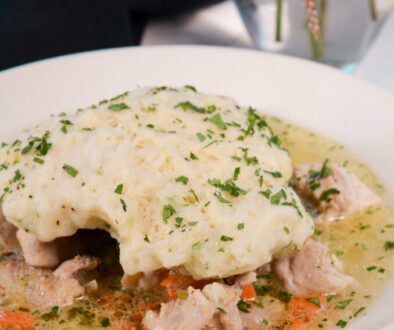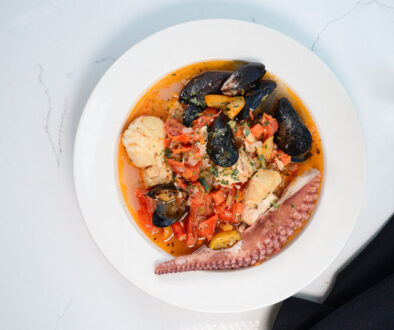1069 Michigan Avenue Landscaping: The Grounds (Part Three)

And finally, we come to the end of our saga. As of the writing of this article, we have “finished” the gardens at 1069. Hallelujah! Well, as finished as any garden ever is. We all know that gardens, by definition, are a work in progress. After all, they are living things.
When last we met, we were discussing the gardens in the backyard. I forgot to mention the stone planter that is home to the herb garden: two kinds of parsley, rosemary, oregano, thyme, and basil are all thriving. Chives are coming soon. Moving on to…
Garden 5 – The Back Fence

This garden was probably the most challenging of all. It is 100 feet long and only six feet deep with no curves. In other words, it is a very long, boring rectangle with a solid, bright white vinyl fence behind it. Beyond the fence is the Physick Estate parking lot (not the most attractive feature of the historic landmark) and the rear courts of the Tennis Club which are surrounded by phragmites and other noxious weeds which, in late summer, grow taller than the fence. So, the goal was to block some of the view, but not all. As you might remember from previous articles, we enjoy a “big sky” here and beautiful sunsets from that direction.
I started by planting five Autaugaville Purple Crape Myrtles. When mature, they will basically double the height of the fence and be pruned so that their canopies start at six feet giving us room to underplant them. Next, I added six Green Mountain Boxwoods and a Blue Point Upright Juniper for structure and winter interest. The color palette in this space takes its cue from the pool. However, try as I might, I have not yet succeeded in achieving as much blue in this bed as I imagined.
In order to mitigate boredom, I broke this lengthy space into small vignettes starting with the section viewed most often from inside the house and from seats on the patio. Its focal point is a small blue ceramic birdbath which is surrounded by three Snow Pavement Shrub Roses. Next, I created a vignette around my favorite fall shrub, Early Amethyst Beautyberry. Although it produces small slightly pink flowers in the spring, this plant is a showstopper in autumn when it is covered with a proliferation of tiny purple berries that balance themselves in rows on top of each branch. The beautyberry is fronted by Blue Star Junipers, Blue Girl Hybrid Tea Roses, Elijah Blue Fescues and blue and white annuals. Last year, they were Beach Bum Blue Evolulus which proved to be disappointing because they did not produce enough color when viewed from far away. This year Aloha Blue Dwarf Ageratum is on display as well as Lanai White Trailing Verbena. They are better, but still not enough.
Next year I plan to plant Bombay Dark Blue as well as white scaevola, which are slower to get started but will thrive in July and August and continue through to fall. That vignette is repeated two more times, which is critical to this type of garden design; otherwise, your garden ends up looking like a series of displays at a garden center. The vignettes are separated by Hameln Dwarf Fountain Grass and Beyond Midnight Bluebeard, another fall performer, flanks each end.
Garden 6 – The Hosta Garden

This part-sun/part-shade space is against the back side of the house (the master bedroom and the sun porch). Since my husband’s only request was fragrance, I began by positioning an old-fashioned lilac directly behind the sun porch. Although it has struggled a little, its familiar perfume wafted into our morning coffee space this spring and was simply delightful.
Happy Returns Daylilies skirt the lilac, and another Blue Point Juniper defines the other end. A Carlesii Viburnum sits in the middle (another heady fragrance plant). In between are different varieties of hostas (many with yellow and white accents), my favorite fern, Visions in Purple Astilbes and a few tuberous begonias to further enhance the yellow palette that brightens this shady space.
Garden 7 – The right side of the back yard against the house

This garden is in almost-complete shade and is a space that is more often viewed by the next-door neighbor than by us. It is also somewhat protected from Cape May’s ever-present wind. Six Roseum Elegans Rhododendron (in groups of three) are interspersed with Mr. Goldsrike Aucuba, all of which are evergreen. The front row was perfect for one of my favorite grasses—variegated hackonechloa (‘Aureola’), and coleus was added for non-stop summer color in the shade.
Garden 8 – The right side of the backyard along the fence

The last garden is still evolving. We began in the back corner by creating another vignette around my must-have Redbud. Although difficult to find, the species is my favorite. I had specced a single trunk since the neighboring crape myrtles are multi-stemmed but was unable to find one. Forest Pansy and other newer cultivars were readily available but just don’t produce the same shade of magenta as the Fort Hill Creeping Phlox beneath it, which blooms at the same time. It almost appears like the tree is raining pink petals. Impatiens (walleriana) are scattered in between the phlox for summer color. Two somewhat modern, yet elegant crane statues rise out of flowers. Behind, three Skip Laurels provide structure and winter interest.
The color palette here changes from blue and purple to pink with the magenta corner signaling the change, but fragrance is still in the forefront. As you walk through this space you are greeted first by Burkwoodii Viburnum in early spring, then a variety of fragrant peonies in late spring and finally Ruby Spice Clethra in mid-summer.
The side fence is another long boring stretch of white. So, here too, we broke it up into groupings of plants that repeat. First three clethra, next three Cran Razz Butterfly Bushes (that keep the color going into late summer) and peonies surround a blue-green mosaic gazing ball, then another group of three clethra and finally one more Skip Laurel which signals the end of the flowers. A vegetable garden–just big enough for a few tomatoes and a couple zucchini–takes advantage of the sunlight at the far end.
The whole length of the front row is dotted by Blue Zinger Carex and Pink Polka Dot Plants which mimic the texture of the opposing garden (hackonechloa and coleus) but fit into the pink palette and like the availability of more sunlight.
Finishing touches

Although ornamentation adds a finishing touch, it is easy to overdo it. Less is definitely more. The goal was continuity and subtlety. So, in addition to the bird bath, gazing ball and cranes, there are two small verdigris garden signs and a (yet to be purchased) bird house. A unique sculpture fashioned from mussel shells that are attached to a piece of driftwood hangs on the fence near the side gate. It was made by a local artist and given to us as a wedding gift, so we had to find just the right spot for it! I also placed one ceramic pot (the same color as the pool tile) in the garden bed that borders the pool. Containers filled with annuals were placed on the front porch and rear patio in order to soften and brighten each space. Spa blue umbrellas and striped pillows complete the picture.
Whether you are creating an interior space or even a party, good design has many layers, each one appealing to a different sense. Gardens obviously are meant to be looked at and can provide fragrance. Although you don’t often touch plants—in fact many don’t like it, varying the textures of the leaves somehow appeals to the sense of touch. Sound is created in this space by the pool fountain, spillway, and a set of wind chimes. You have to ask our bunnies about how the garden tastes!
Lighting, other than the pool light, has yet to be installed. I plan to uplight the hornbeams, crape myrtles and some of the other specimen trees. Rope lighting is planned for underneath the stair treads both for aesthetics and safety.
Lastly, spring blooming (rabbit-proof) bulbs in shades of yellow and purple will be added this fall.
The Future
No matter how much you think you know, nature often has surprises in store for you and there is always more to learn. My yard is a testing ground. We planted some old favorites and some new varieties. We’ll see what works and what doesn’t. Stay tuned for an update—same time next year!



